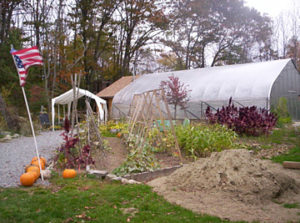 |
| From the outside, the garden and greenhouse at Home Grown look just like those at any other small farm enterprise. The ordinary exterior hides a unique self-sufficient system of raising large quantities of fish and vegetables in a small space. Alice Percy photo. |
by Alice Percy
On a curve in Route 220 in Maine’s Washington village, near Route 17, hangs a wooden sign advertising “Aquaculture Engineering, Inc.” The driveway leads past the house to a gravel walkway that goes past a mid-sized barn and a small garden to an ordinary-looking greenhouse. Like many ordinary-looking farmsteads in Maine, this one offers much more than meets the eye. The greenhouse and the nearby outbuildings hide a unique, sustainable system of food and energy production. John Stewart and his wife, Cynthia Rosen, own and operate both Aquaculture Engineering (an aquaculture equipment company) and Home Grown, a food growing and marketing business partly intended to advertise the system produced by Aquaculture Engineering.
Five years ago, Stewart injured his neck and back and was seeking a new way to occupy himself while out of work. While researching greenhouse and hydroponic systems, he came across references to indoor aquaculture and so-called “aquaponic” systems that combine large fish tanks with the hydroponic culture of garden vegetables. Soon after, Stewart and Rosen found themselves the proud new owners of an aquaculture equipment design business from Australia.
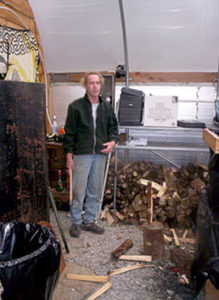 |
| John Stewart, part owner of Aquaculture Engineering and Home Grown, splits wood to fire a boiler that supplements the biodiesel heating system for the greenhouse. Alice Percy photo. |
Their attempt to import the aquaponics concept to the United States met with limited success. Many people were interested, but most lacked the $50,000 required to invest in the base production model, and banks were unwilling to give loans for a technology largely unproven in the United States, even though it had been used successfully in other parts of the world. They also found that aquaculture was a hot-button issue with environmentalists. “Fish farming in the U.S. has usually been in natural bodies of water,” says Stewart. “That’s cheap and convenient, but environmentally damaging.”
The Aquaculture Engineering technique of raising fish is completely divorced from natural bodies of water and does not cause nutrient pollution from fish waste or genetic pollution from escaped farm stock. Nevertheless, many people hear the phrase “fish farm” and immediately have negative thoughts because of all the problems associated with the ocean farming of salmon. “My customer base should be the environmentalists, but they need to be wooed.” Stewart and Rosen decided to build a small aquaponic system to demonstrate the technique and produce a successful precedent for those seeking bank loans to buy the equipment.
Home Grown’s first few batches of fish were trout, raised from fingerlings purchased from hatcheries. One of the couple’s objectives, however, was to produce “clean” fish, free from environmental contaminants, and the trout hatcheries were subject to the usual background levels of mercury and other pollutants. They have now switched to producing tilapia, a freshwater, tropical fish that gives live birth, allowing them to keep their own broodstock. These fish are typically farm-raised in ponds – where, according to Stewart, their flesh often acquires a muddy flavor, leading to low market value. Nevertheless, tilapia have become increasingly common in supermarkets as many wild-caught fish stocks are depleted. Stewart and Rosen chose to raise tilapia because they are prolific breeders and fast growers – and above all because the Department of Inland Fisheries and Wildlife permits their importation, as they are unable to live in Maine waters. Tilapia require water temperatures in the high 60s to survive and will not grow well unless the water is at least 80 degrees.
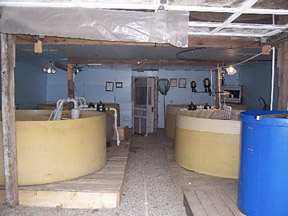 |
| Tilapia, or Nile perch, are raised in these large indoor tanks. Fed with clean well water and protected from the elements, the fish are virtually free of environmental contaminants such as mercury. Photo courtesy of John Stewart. |
The tilapia are raised in what are essentially “giant aquariums.” The tanks are filled with regularly tested, clean well water and are kept inside, out of the pollution stream. (Rain carries multiple environmental contaminants, notably mercury, and bird feces are a major vector of fish diseases.) They are fed primarily a commercially prepared, certified organic, vegetable-and-grain-based fish food, but they also receive duckweed grown in the greenhouse and an occasional treat of earthworms. Bacteria growing naturally in the water consume the ammonia from the fish waste and convert it to nitrates, the form of nitrogen most accessible to plants and least toxic to fish. “Essentially, we are bacteria farmers first,” says Stewart. “We grow fish to feed the bacteria, because the bacteria have got to be there.” The resulting product is fish with white, flaky, mild-flavored, mercury-free flesh.
Once each day water is flushed through the tanks to eliminate the solid waste and nitrogen-rich water, which enters the hydroponic system in the greenhouse to feed the growing plants. Excess tank water is sometimes pumped out of the greenhouse to irrigate outdoor lawn and garden areas. Stewart compares the fish-bacteria-plant sequence to “composting your chicken manure and growing your corn on the compost.” Most greenhouse plants are grown in small plugs of growing medium set in styrofoam rafts floating in the nutrient-rich fish water. A few plants are grown in soil beds that are irrigated conventionally. Water left in the greenhouse after the plants have used the nutrients could theoretically be returned to the fish tanks, but in practice the water “disappears” into the produce. (Lettuce, Stewart points out, is 98% water.)
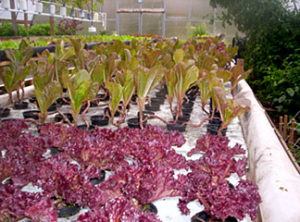 |
| Dozens of young lettuce plants float in a bath of nutrient-rich water from the fish tanks next door. Home Grown produces many varieties of lettuces and other greens. Its mesclun mix is available at the farm’s store at their wholesale price of $8/lb. Alice Percy photo. |
The Maine Technology Institute awarded a grant to Aquaculture Engineering to research the feasibility of growing duckweed on indoor fish tanks for a certified organic livestock feed. The project was successful – the duckweed produced prolifically at little cost and was certified by MOFGA – but Stewart and Rosen have dropped their certification because their fish operation is too small to grow enough duckweed to make the marketing effort worthwhile. The vegetables in the greenhouse are not certifiably organic for human consumption because the fish waste in the irrigation water does not meet the 120-day waiting requirement for raw manure applications.
The third component of the Home Grown system is the small biodiesel plant in the nearby barn, operated mostly by Jarmin and Jessica Kaltsas. The Kaltsases were “essential personnel” in the startup process for the Home Grown operation, and Jessica continues to help extensively in the greenhouse, but they focus mainly on producing biodiesel to heat the greenhouse, fish tanks and house, and to run some of the families’ vehicles.
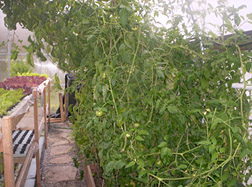 |
| Tomato plants are irrigated regularly with nutrient-rich water from the fish tanks. Alice Percy photo. |
They collect used vegetable oil from fairs, restaurants and Home Grown customers. After filtering out the large particulate matter, the oil is heated to 120 degrees using a biodiesel-powered boiler. Particulates down to 5 microns are then filtered out as the oil is passed into barrels, where it is combined with lye and methanol and heated to 140 degrees to two hours. The waste products – glycerine and lye – separate from the mixture, leaving pure biodiesel fuel behind. The plant can make 40 gallons a day, but they do not produce that much on a regular basis due to restricted storage space for vegetable oil and biodiesel. Stewart hopes to convert his equipment to run on straight vegetable oil instead. “I don’t actually think biodiesel has much of a future,” he says. “Burning straight vegetable oil is so much simpler, it doesn’t require the addition of other chemicals.”
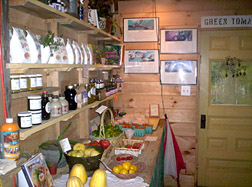 |
| Home Grown’s retail space is small, yet it boasts a nice selection of local and prepared foods and artwork. Alice Percy photo. |
Stewart and Rosen’s vision is to market a franchisable model of sustainable local food production and marketing centered on a self-sufficient aquaponic operation. Seventeen used box trailers, he says, can be arranged to form an indoor fish farm with a central retail space. The whole assembly would be topped with a large greenhouse.
They can also build home- or family-sized systems that will produce a couple of hundred pounds of fish a year and nutrients for hydroponics.
Part of the company’s purpose would be to help producers “jump through all the regulatory hoops” involved in setting up a food business. The regulatory process is complicated for fish farmers, who in Maine are regulated by the Department of Inland Fisheries and Wildlife instead of by the Department of Agriculture.
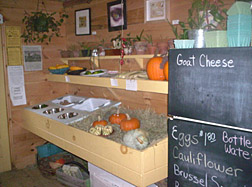 |
| Squash for sale in Home Grown’s store. Alice Percy photo. |
Their primary focus, however, is encouraging local consumption of locally produced food. “People need to know where their food comes from, whether it’s vegetables or meat. We believe in local first, then organic – if local farmers can find a lucrative market, then they can afford things like certification.” To this end, they maintain a small retail space where, aside from marketing their own fish and produce, they provide space for other local producers of food and art. It’s certainly not supplying the town of Washington with all its groceries yet, says Stewart, “but I see a place for interim solutions.” For more information, visit Homegrownfarmandmarket.com

